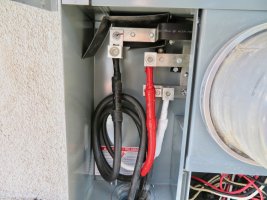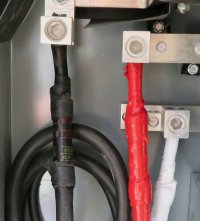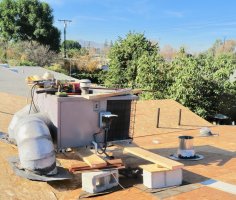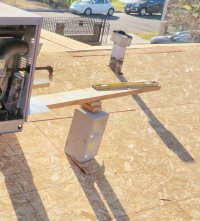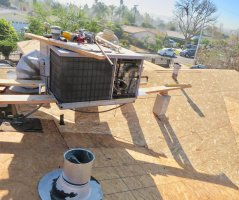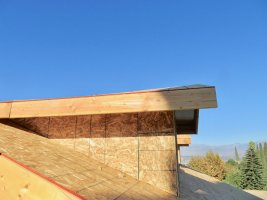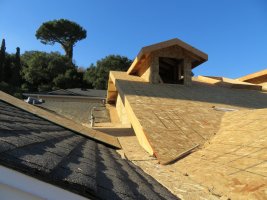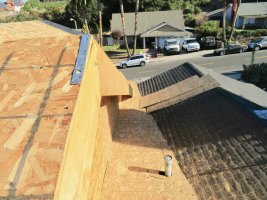You going make them fix it? That is one of my pet peeves that nobody seems to be able to set boxes so the devices do not float & unless there is some mean of support they shatter standard wall plates when a plug is inserted or removed.
-
Welcome to The Building Code Forum
Your premier resource for building code knowledge.
This forum remains free to the public thanks to the generous support of our Sawhorse Members and Corporate Sponsors. Their contributions help keep this community thriving and accessible.
Want enhanced access to expert discussions and exclusive features? Learn more about the benefits here.
Ready to upgrade? Log in and upgrade now.
You are using an out of date browser. It may not display this or other websites correctly.
You should upgrade or use an alternative browser.
You should upgrade or use an alternative browser.
An average day
- Thread starter ICE
- Start date
conarb
REGISTERED
They still make steel plaster rings that can be screwed to the box to screw the outlets/fixtures to.
This inspection was for a service panel and it was my first time at this job. This mistake should have been caught at the rough electrical inspection but alas and alack, that was approved by another person.You going make them fix it? That is one of my pet peeves that nobody seems to be able to set boxes so the devices do not float & unless there is some mean of support they shatter standard wall plates when a plug is inserted or removed.
I don't make people fix anything.....I refuse to approve the work and they have options......one of which is fixing the mistake.
Conarb suggested metal mud rings. Metal mud rings do not mate with these plastic boxes. Furthermore, the random nature of the mistake rules out mud rings. Next on the list is box extensions. That solution relies on the extension mating with a solid surface and drywall/mud does not qualify as it can crumble over time. That is especially true with tamper resistant receptacles because it takes greater pressure to insert an attachment plug. The only fix is to start over. Something that I learned early on is that it is never too late to start over.
Speaking of starting over.....it happened twice that day. The job was a new house.
The worker was installing the copper pipe at a second floor bathroom. Just about done, he was. I saw that he was fixing to insert and solder the six inch piece in the picture. What I didn't see him do was ream the pipe. I summoned an English proficient translator and asked the worker if he reamed any of the pipe. The workman immediately started to ream the pipe with a razor knife. As it turned out the workman stated that he did not ream any of the pipe. The copper pipe was nearly completed and I wrote a correction to start over. I expect a pail of fittings and I will be cutting out a random spot or two. I took these for proof of the violation.
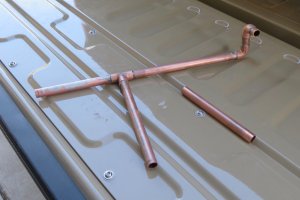
Back to the outlet boxes. I was met by a man whom I assumed to be the contractor. The electric service was not ready for inspection as none of the conductors have been landed. I first noticed the outlets for lights and receptacles on the outside. The plaster is an inch thick before you hit the plastic box. I saw the A/C line-set poking through the wall with no jack.....the clean-out set back. It is emblematic of a less than stellar performance by so many. I took a picture.

So in the house I go. It is going to be a splendid home. The ceilings are 12' high. The rooms are large. The paint scheme is tasteful and the walls are without imperfection. That's gonna change up. The guy that I thought was the contractor owns a concrete pump and also this house. He hired contractors that he knew from his work. I made it clear to him that If I am tasked with the final inspection for his house I will not approve the electrical even though it has been signed off previously.
The likely outcome is that I will be banned from that job. Maybe the job with the pipe too.....could I be that lucky?
Last edited:
conarb
REGISTERED
Tiger said:Conarb suggested metal mud rings. Metal mud rings do not mate with these plastic boxes. Furthermore, the random nature of the mistake rules out mud rings. Next on the list is box extensions. That solution relies on the extension mating with a solid surface and drywall/mud does not qualify as it can crumble over time.
I've never run into this since I've never used plastic boxes, but is there a code cite stating that you can't mate steel with plastic?
I've never run into this since I've never used plastic boxes, but is there a code cite stating that you can't mate steel with plastic?
How are you going to bond the metallic ring to the EGC? Otherwise as soon as the device is removed the connection is lost, sounds like Bozo the "electrician" is going to need to buy some Smart Boxes® if they don't wish to do a lot of patching.
conarb
REGISTERED
How are you going to bond the metallic ring to the EGC? Otherwise as soon as the device is removed the connection is lost, sounds like Bozo the "electrician" is going to need to buy some Smart Boxes® if they don't wish to do a lot of patching.
I'm out of my element here not being an electrician, I leave it to them, but as I understand it with a metal box the entire box is grounded so there is no problem with a plaster ring, with a plastic box a lug-nut is bonded and the outlets/fixtures are wired to the lug-nuts, so how does adding a plaster ring change anything with a plastic box?
I'm out of my element here not being an electrician, I leave it to them, but as I understand it with a metal box the entire box is grounded so there is no problem with a plaster ring, with a plastic box a lug-nut is bonded and the outlets/fixtures are wired to the lug-nuts, so how does adding a plaster ring change anything with a plastic box?
All metallic parts need to be bonded together, relying on the device to bond metallic parts is no good, the fixture mounting straps when used w/ a NM box have a ground screw so that is taken care of, my opinion is use non-metallic rings w/ NM boxes, & metal rings with metal boxes, but that is not going to help the lousy install in the earlier photos, as plaster rings do not mate w/ the boxes used. I used to be a fan of plastic boxes but a 4 square box, AKA a "1900 box" & a plaster ring 1/8" deeper then the finish material, 5/8" for 1/2", & 3/4" for 5/8" drywall, makes for a nice clean install.
steveray
SAWHORSE
Are they relying on the gypsum for ground?
mtlogcabin
SAWHORSE
That is one of my pet peeves that nobody seems to be able to set boxes so the devices do not float & unless there is some mean of support they shatter standard wall plates when a plug is inserted or removed.
Next on the list is box extensions. That solution relies on the extension mating with a solid surface and drywall/mud does not qualify as it can crumble over time. That is especially true with tamper resistant receptacles because it takes greater pressure to insert an attachment plug. The only fix is to start over.
Metal cover plates might work
Are they relying on the gypsum for ground?
Gosh....I hope not.
Metal cover plates might work
And they might not.
conarb
REGISTERED
ICE,
Post #2538, They could use "Brent the Kilted Warrior" on that job!
Naw, Brent is too smart a guy to use OSB. I want to know how Tiger gets up there to take these pictures? Around here inspectors are not allowed on roofs, maybe you are firing up the old T-6 and flying him over to take thse pictures?
I want to know how Tiger gets up there to take these pictures?
Usually by ladder. I crawl through windows. Climb trees. if you leave me alone, I will come down on my own. I sense a drone in my future.
Last edited:









